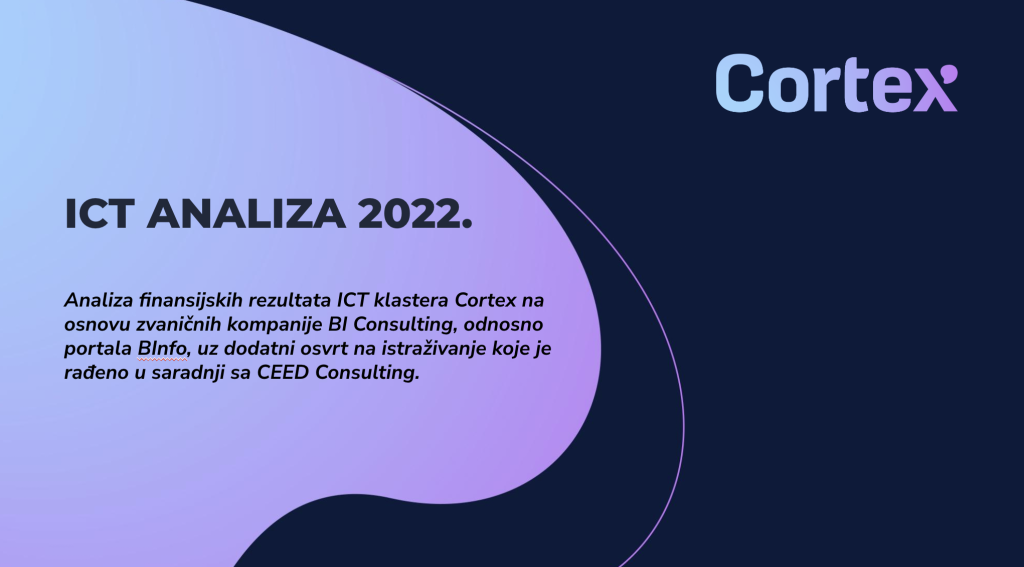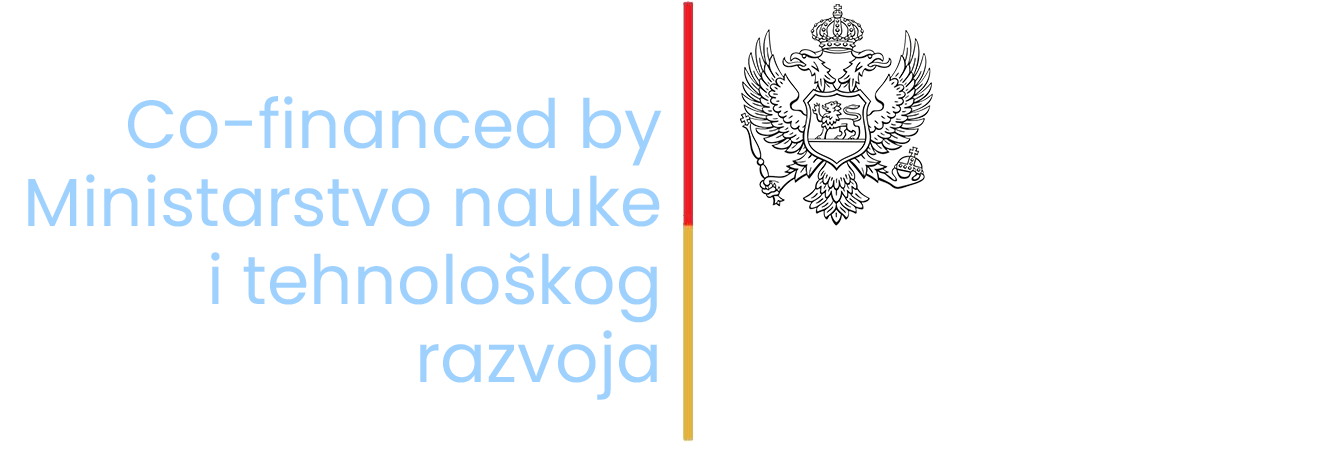Numbers confirm: IT has the potential to become a strategic sector for the development of Montenegro

The potential of the IT industry is receiving increasing public attention, and Montenegro is becoming an important country for IT investments. The actual extent of this potential was demonstrated by the numbers presented at today’s press conference organized by ICT Cortex and the Chamber of Economy of Montenegro, where the results of an ICT research study were presented. Montenegro is experiencing growth in the ICT sector in terms of the number of companies, employees, as well as revenues and profits. This was shown by the analysis of the IT sector in Montenegro conducted by the consulting firm “CEED Consulting” for the needs of the ICT Cortex cluster, under the auspices of the Reconomy program. One particularly interesting finding from the research is that the export of computer services increased to a record 21% in 2022, compared to only 3% in 2017. “The growth in the number of companies has been influenced by the war in Ukraine. Despite the crisis, the IT sector is experiencing growth in all observed parameters, and the IT industry has also seen revenue growth. The analysis showed that companies are facing a shortage of qualified workforce,” said Jovana Vujačić from the company “CEED Consulting.” Among the 70 surveyed companies, the following interesting data stand out: Nina Drakić, the President of the Chamber of Economy of Montenegro, stated that, in addition to tourism, agriculture, and energy, the IT sector is recognized as a strategic sector. “The IT sector had the highest growth last year, which indicates its potential,” said Drakić. Statistics show that the number of registered companies in the ICT sector has been steadily increasing on an annual basis. In the previous year, 1,497 companies were registered, and from the beginning of this year until April, 313 companies have been registered. “In the last five years, the structure of the ICT sector has changed. Statistics show that the IT sector accounts for 84% of the ICT sector. Compared to other sectors, the ICT sector deserves to be a priority economic branch,” said Nada Rakočević, Secretary of the Committee of Information and Communication Technology Associations within the Chamber of Commerce of Montenegro. She further highlighted key figures, pointing out a nearly 70% increase in the number of companies and a 44% increase in employment. The ICT Cortex cluster announced that revenues in the ICT industry reached 602.432.407 million euros last year. “Net profit increased by over 100% compared to 2019. With the growth of ICT companies, the number of employees also increased by 30% last year compared to 2021,” said Milena Aković from the ICT Cortex cluster. She emphasized the need to highlight the significance and potential of the IT industry, which should become a strategic sector. Vladan Tabaš, the CEO of Čikom company and the President of the Board of Directors of ICT Cortex, stated that the IT sector is growing rapidly, but the level of digital transformation in society is not satisfactory. “IT has advanced to a great extent, but the digital transformation in Montenegro is slow. We are entering the digital world, and perhaps the turning point was the COVID-19 pandemic. The obstacle is our educational system, which does not provide the necessary workforce. We need skilled professionals, and therefore, we appeal for significant changes in Montenegro’s educational system,” said Tabaš.
Cortex analyzes the ICT industry, achieves record numbers

Based on the ICT analysis and research conducted by CEED Consulting, we can conclude that the ICT sector is one of the fastest-growing, at least in the context of Montenegro. This is evident from the rapid increase in the number of companies involved in this activity, their impressive financial revenues, and the growing interest of people in our community in this field. ICT Cortex, a cluster with a primary focus on education, internationalization, and digital transformation, has analyzed the business performance of the Montenegrin ICT sector. The criteria for ranking success were total revenues, net results, the number of employees, and the number of companies. An important contribution to the analysis was made by the research conducted by the consulting company CEED Consulting. Additionally, BI Consulting, with its portal BInfo.me, was a significant source of data on specific industry codes. ICT Sector in Montenegro This analysis covered 1,049 companies that were part of the Montenegrin ICT sector in 2022 alone. However, to make the analysis comprehensive, the period from 2019 to 2022 was considered, tracking the trends of growth or decline in the three specific groupings of the ICT sector: IT services and products, telecommunications, and trade of IT equipment. Regarding the revenues generated in the ICT field during the previous year, the figures were more than impressive. The total revenue for the ICT sector in 2022 amounted to as much as 602 million euros, which is 23 percent higher than in 2021. The majority of the revenue comes from the telecommunications sector, followed by IT services and products, and trade of IT equipment. Net earnings have also significantly increased over the past four years, with a growth rate of 102 percent compared to 2019. Some of the companies that particularly stood out in terms of revenue in the previous period and made significant contributions to the revenue growth in the Montenegrin ICT sector are M-tel, Crnogorski Telekom, One, Kodio, Comtrade, and Coinis. Below, you can see the individual contributions of each of the mentioned areas to the information and communication technology sector. IT Services and Products Regarding the IT sector, we analyzed 725 companies actively operating in the local and international markets. The largest number of these companies are engaged in computer programming and consulting activities in the field of information technology, while specialized areas such as computer game development and software publishing are represented in a smaller number. It is worth noting that this field has seen a significant increase in the number of companies, with a growth rate of 46 percent compared to 2021 and a remarkable 109 percent compared to 2019. Companies in the IT services and products sector have made the most progress in the past four years when considering parameters such as total revenue, net results, and the number of employees. Total revenues increased by 45 percent compared to 2021, net results increased by 87 percent, and compared to 2019, the same parameter increased by an impressive 450 percent. The number of employees adequately follows the revenue growth, as indicated by the fact that over 3,400 workers have been employed in the IT products and services sector, which is 61 percent more than the previous year and a remarkable 161 percent increase compared to four years ago. When looking at the specific specialization, the largest number of companies are engaged in computer programming and IT consulting activities. Some of the companies that achieved the best results are Epam Systems Montenegro, Domen, Data Design, Čikom, and Logate. Telecommunications In the field of telecommunications, we analyzed 66 companies operating in our market. Over 60 percent of them are registered under the activity code “other telecommunications activities,” while a smaller number are involved in satellite and wireless communications, as well as cable telecommunications. Here, we have a slightly different picture compared to the IT sector. The growth rate of the number of companies over the past four years is only 1.5 percent, indicating that the telecommunications sector is relatively stable, with few changes in the number of firms in the previous period, averaging 64. Companies in the telecommunications sector have traditionally continued to generate impressive revenues. However, these revenues do not show significant fluctuations like those observed in the IT sector. The total revenue of Montenegrin companies engaged in telecommunications activities amounted to 266 million euros, which is nearly six percent higher than in 2019. Net results also did not experience significant growth, with an increase of less than 2 percent compared to 2021 and a decrease of nearly 17 percent compared to four years ago, indicating that the overall profit in this sector was significantly higher in 2019 than it is today. The three traditional telecommunications providers operating in our market, namely M-tel, Crnogorski Telekom, and ONE, achieved the best results in this field. Significant results were also achieved by companies such as Telemach, Ericsson AB, the Agency for Electronic Communications and Postal Services, and Network Communication. The total number of employees in this sector is 1,973, with as much as 65 percent of them employed in the three leading companies in the telecommunications sector (M-tel, Crnogorski Telekom, and ONE). This number is nearly 14 percent higher than in 2019. Trade of Computer Equipment Regarding the sector related to the trade of computer equipment, it should be highlighted that the total revenue in 2022 amounted to nearly 121 million euros, which is 33 percent higher than the previous year. Compared to 2019, this represents a 54 percent increase, while net profit for the same period has increased by 107 percent, reaching almost 6 million euros. The majority of companies in this field are primarily engaged in the wholesale trade of computers, computer equipment, and software, while a smaller number focus on the retail trade of telecommunications equipment, audio, and video equipment, as well as the wholesale trade of electronic and telecommunications parts. The number of employees in this sector increased by 16 percent in the previous year, reaching 664, which is a significant advancement, especially
Study visit: Bosnia and Herzegovina

The period behind us was marked by a study visit to Bosnia and Herzegovina. The ICT Cortex team together with representatives of the companies Amplitudo, Bild Studio, Čikom, and Simes Inženjering and accelerator Digital Den was in Sarajevo and Mostar from 6-9. December. Within four days of a condensed schedule, we visited leading IT companies and innovative organizations in Sarajevo and Mostar, the companies Atlantbh, Authority Partners, Bosnia, and Herzegovina Futures Foundation, Fondacija Mozaik, Isatis, Klika, NSoft, Ministry of Programming, Mistral, PING Software & Services, Symphony, Verlab, and Zira. Our hosts in Sarajevo were representatives of the Bit Alliance association, while in Mostar it was the Science and Technology Park Intera, where B2B meetings with IT companies from Mostar were organized. This study visit was an ideal opportunity to connect and exchange the knowledge of the representatives of our delegation with the most important actors in the ICT market of BiH.


